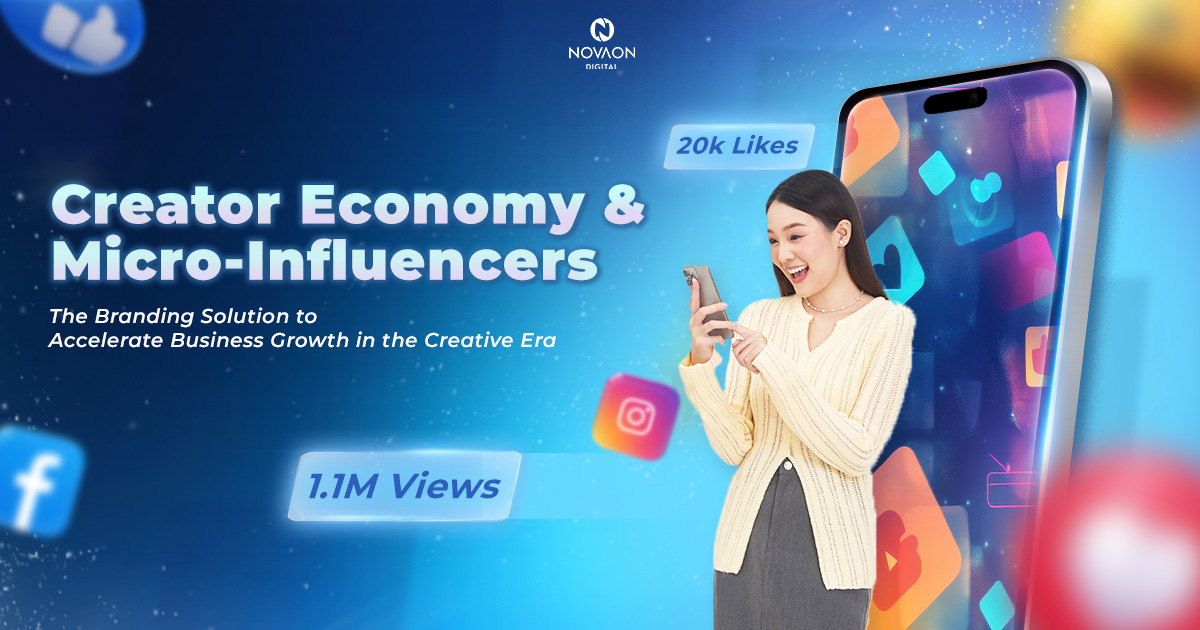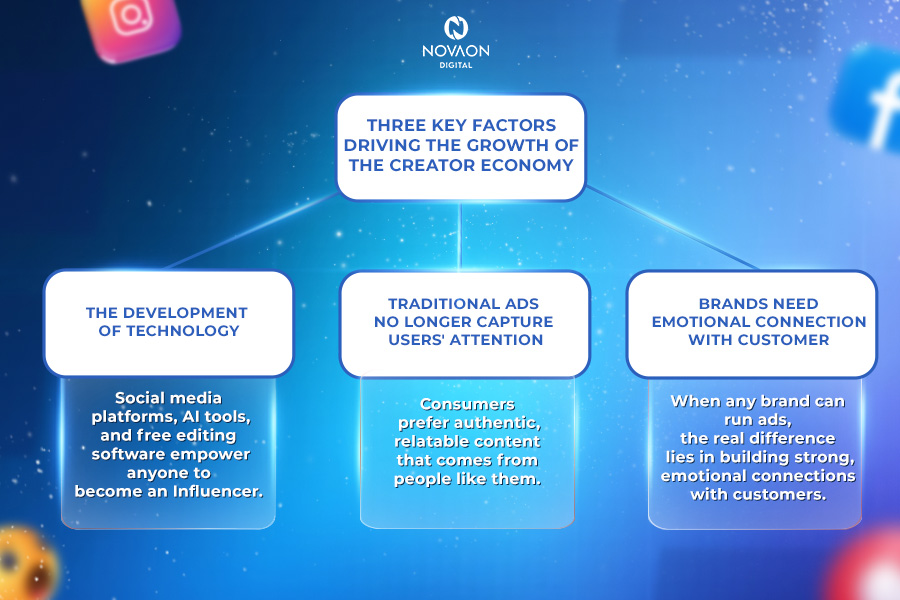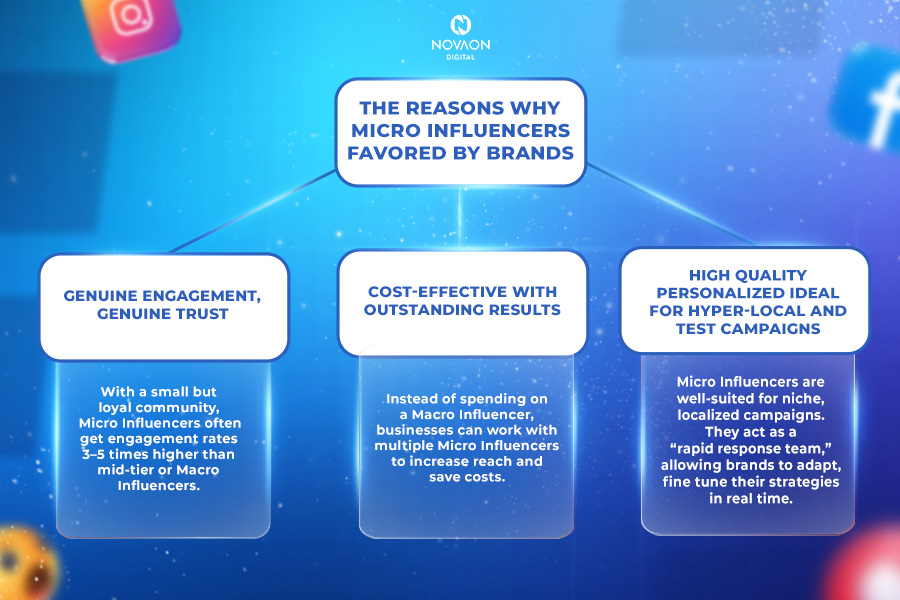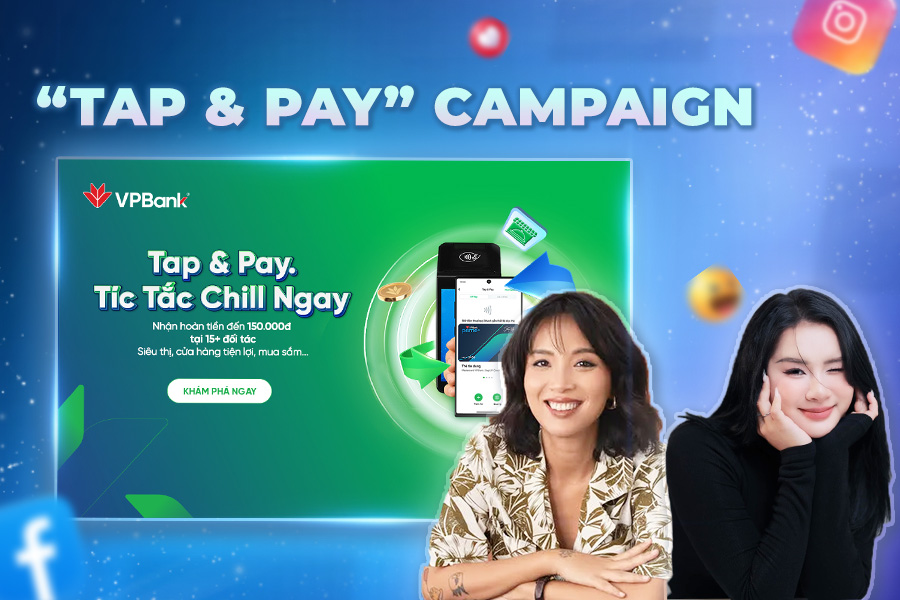
Introduction
In the digital era, consumer behavior is undergoing a profound transformation. Audiences are no longer easily persuaded by one-way advertising as in the past. Instead, today’s consumers actively seek authentic, personalized content—especially when it comes from sources they trust.
Rather than “watching advertisements,” people now prefer “listening to real-life recommendations.” They place their trust in true stories told by relatable individuals—friends, colleagues, niche experts—over brands or celebrities who may feel distant and disconnected. As a result, the role of content creators, particularly micro-influencers, is becoming increasingly prominent in modern marketing strategies.
What makes them stand out is not fame, but relevance: the right niche, the right community, and the right values. A creator who shares financial knowledge in a clear and accessible way can profoundly impact thousands of young people struggling with income management.
This shift lays the foundation for the emergence of a new concept: the Creator Economy. In this model, individuals are not just consumers—they can become businesses, brands, and independent marketing channels. They don’t just inspire; they generate revenue, build communities, and influence purchasing decisions on an increasingly broad scale.
Creator Economy – A New Communication Model, A New Strategy
1. The Essence of the Creator Economy Model
The Creator Economy represents a new economic paradigm where individuals can generate income and influence through their content, skills, or expertise on digital platforms such as YouTube, TikTok, Instagram, Facebook, or Substack. Within this ecosystem, a person can simultaneously be a creator, a business, a content producer, and an independent personal brand.
No massive budget is needed—no professional studio required. With just a smartphone and a unique perspective, anyone can “go live” and create real value for both themselves and their communities.
2. Three Key Drivers Behind Its Rise
The rapid rise of the Creator Economy is no coincidence. It is the result of fundamental shifts in technology, consumer behavior, and brand strategy. As audiences demand greater authenticity and brands require broader media presence, this model has emerged as a timely solution for both. There are three main driving forces accelerating the growth of the Creator Economy:
➤ The development of technology: Social media platforms, AI tools, and free editing software have empowered everyone with a personal “stage.” From stay-at-home mothers to financial experts—anyone can now produce deeply personalized content.
➤ Traditional ads no longer capture users attention: After decades of exposure to banner ads and scripted TVCs, modern consumers increasingly favor genuine, relatable content delivered by “people like them.” This creates opportunities for content creators to promote products through their own voices and stories.
➤ Brands need emotional connection with customer: In an age where any business can run ads, the true differentiator lies in relationship-building—something creators excel at far better than any billboard or pop-up. The larger the creator network on social platforms, the more diverse and impactful branded content becomes—in terms of messengers, messaging approaches, and even content settings. This significantly boosts opportunities for brands to promote their products and services through creators.

Three key factors driving the growth of the Creator Economy (Cre: Novaon Digital, 2025)
3. Impact on Marketing Strategy
The rise of the Creator Economy is compelling brands to redefine their approach to consumer engagement. It is no longer about “hiring a KOL to deliver a scripted message,” but about forming strategic partnerships with creators—as content collaborators and co-creators who accompany the consumer on their brand experience journey.
The roles of creators and brands have essentially been reversed. Today, creators are no longer just “messengers”—they are trust builders. They possess deep insight into their communities, understand what their audiences need and want, and know how to communicate in a way that resonates. This level of understanding often surpasses what traditional marketing departments can capture through data and metrics alone.
Furthermore, the Creator Economy has redefined both the terminology and practice of “influencer marketing.” Whereas influencers were once synonymous with celebrities, the focus has now shifted toward nano-influencers and micro-influencers—individuals who may have smaller communities but significantly higher engagement and credibility.
This is especially true in an environment where some macro-influencers have begun to lose consumer trust due to the saturation of paid product placements on social media. Although their reach may remain broad, their ability to effectively persuade and drive purchase consideration has diminished. Compounding this issue is the high cost of booking macro-influencers, which can be prohibitive for many brands.
Overall, the Creator Economy is not only transforming how marketing is done—it is unlocking a more sustainable path for brand building. It emphasizes relationships and authenticity over massive and costly media spending.
Micro-Influencers – From Small Connections to Wide-Scale Impact
1. Who Are Micro-Influencers?
Micro-influencers are individuals who maintain a moderate following, typically between 5,000 to 50,000 followers. However, their value lies not in the size of their audience, but in their high engagement rates, authentic content, and deep community ties.
Unlike many highly commercialized macro-influencers, micro-influencers are often seen as trusted friends or niche experts in specific areas such as skincare, personal finance, early childhood education, or pet care. They don’t speak to a crowd—they speak to a close-knit audience that trusts them every day.
2. Why Are Micro-Influencers Favored by Brands?
The growing popularity of micro-influencers is driven by three distinct strategic advantages:
➤ Genuine engagement, genuine trust: With small but loyal communities, micro-influencers often generate 3 to 5 times higher engagement rates than mid-tier or top-tier influencers. Their content feels natural, relatable, and emotionally resonant.
➤ Cost – effective with outstanding results: Instead of investing their entire budget on a single celebrity, brands can diversify their strategy across multiple micro-influencers. This allows them to expand reach across segmented audiences with far greater cost flexibility.
➤ High quality personalized ideal for hyper-local and test campaigns: Micro-influencers are especially effective for targeted, niche campaigns requiring a local voice or message experimentation. They act as a “rapid-response team” that helps brands adapt strategies in real time.

The reasons why Micro Influencers favored by brands
(Cre: Novaon Digital, 2025)
3. Case Studies
To better understand the power of micro-influencers and the Creator Economy in modern marketing strategies, we can look at several notable campaigns in the Vietnamese market, implemented in collaboration with Novaon Digital.
Case Study 1 – VPBank: “Tap to Pay, Express Your Style”
As part of its efforts to promote contactless payment services among younger users, VPBank partnered with Novaon Digital to launch the TapnPay campaign—taking a distinctive approach by activating micro-influencers in the lifestyle and personal finance spaces, along with Gen Z content creators.
The campaign focused on real-life content that illustrated “tap-to-pay” scenarios aligned with a dynamic, modern, and individualistic lifestyle. Instead of merely describing product features, influencers shared their personal experiences of using contactless payments in everyday settings such as cafés, convenience stores, and cinemas.
Although the campaign did not rely on a large number of influencers, it still achieved remarkable effectiveness—drawing widespread attention and encouraging active community participation. This success was the result of strategic and thoughtful influencer selection: rather than pursuing scale, the brand prioritized quality, partnering with trusted figures who had high engagement and real influence within their communities—such as VJ Thùy Minh, Tiêu Thố, and Trí Phan.

Case-study VPBank – “TapnPay”
(Cre: Novaon Digital, 2024)
Results After 1.5 Months of Implementation
- Over 1 million engagements and 5 million views generated within six weeks
- Reached 10 million impressions across social media platforms
- Achieved 112% of the original KPI target
What’s most notable is that this was not a “celebrity-driven” campaign. It was a campaign built on authentic trust from real users—individuals who represent the next generation of consumers.
Case Study 2 – Viettel Money: “A Peaceful Tết – Sharing Love”
Tết 2022 marked the third year of the COVID-19 pandemic, a time when traditional values of family reunion and togetherness were deeply challenged. In that context, Viettel Money, a newcomer in the fintech sector, chose to forge emotional connections rather than rely on mass communication.
The campaign aimed to bring the product closer to the general public—especially urban youth who live fast-paced, tech-savvy lives, yet are often overlooked in traditional Tết marketing initiatives.
In collaboration with Novaon Digital, the campaign “A Peaceful Tết – Sharing Love” was launched using the Onfluencer solution, which leverages AI and Big Data to precisely select relevant micro-influencers such as Ăn Sập Hà Nội, Bếp Trưởng Review, and Hải Chiều Schannel.
These influencers shared real-life experiences of using the Viettel Money app—from splitting bills to making seamless payments—woven into relatable daily scenarios. The result was a modern Tết atmosphere, deeply rooted in authenticity and the spirit of sharing, resonating with the younger generation.

Case-study Viettel Money – Lucky Money Shake“Tết an lành, chia sẻ yêu thương”
(Cre: Novaon Digital, 2022)
Results After 1.5 Months of Implementation
- Achieved 94 million impressions, a 230% increase compared to the initial plan
- Increased app downloads by 600% compared to pre-campaign levels
- Boosted social media discussions by 120.6% compared to 2021.
These two case studies clearly demonstrate that in the age of “real people, real stories marketing,” micro-influencers are not just media channels—they are emotional bridges between brands and consumers. Authenticity, closeness, and personalization are the driving forces behind an impact that far exceeds traditional media budgets.
4. Strategic Recommendations for Brands Looking to Develop Creator Economy and Micro-Influencer Ecosystems
As the Creator Economy continues to expand, brands must move beyond simply “collaborating with influencers” toward building a long-term, strategically aligned engagement model. Developing a high-performing micro-influencer ecosystem requires a reimagined brand experience mindset—integrating strategic thinking, creative agility, and technological enablement.
Recommendation 1: Combine Creator Content with Paid Media – Real Content, Wide Reach
One proven formula used by many leading brands is to utilize creator-generated content as the core creative asset, then amplify its reach through paid digital media. This approach captures the best of both worlds: the authenticity and relatability of creator content, paired with the distribution power of digital advertising.
Example: A short TikTok video by a micro-influencer sharing a personal finance tip can be tagged by the brand and boosted through ads to reach millions—while still preserving its organic, authentic feel in the eyes of viewers.
Recommendation 2: Apply the S–C–T Model (Strategy – Creative – Technology) to Enhance Brand Experience
Among the current approaches for developing Creator Economy strategies, Novaon’s S–C–T model stands out as an effective framework for designing and deploying comprehensive influencer marketing programs. This model is especially relevant for brands seeking to operationalize their creator ecosystem vision.
The S–C–T model offers a holistic and agile framework for brand strategy execution. It enables brands not just to approach influencers as media assets, but as long-term strategic partners, thereby laying the groundwork for a more resilient and differentiated brand presence in the Creator Economy era.
Recommendation 3: Build End-to-End Brand Experience
In today’s fragmented media landscape, creators are not just message carriers—they are storytellers who guide the entire brand journey. Therefore, influencer marketing strategies must be tightly integrated into the brand experience—from awareness to conversion.
Ensuring consistency across all touchpoints allows brands not only to attract attention but also to maintain lasting emotional connections with customers throughout their journey.
Recommendation 4: Opt for Comprehensive, Expert-led Solutions
In an age of multi-channel communication and increasing consumer demand for personalization, choosing an end-to-end influencer marketing solution enables brands to ensure message consistency, cost efficiency, and maximum effectiveness across each touchpoint.
Instead of fragmented bookings or inconsistent in-house execution, brands can maintain full control over the process—from influencer selection, content production, and distribution to performance measurement—via a seamless, streamlined journey that boosts brand visibility and conversion.
Novaon Digital, through its Onfluencer solution, offers a robust platform with standout features for brand building. With AI-powered data analytics, Onfluencer generates an Influencer Index score (out of 100, equivalent to 5 stars) to help brands accurately assess each KOL’s impact and select the right partner aligned with campaign goals and budgets.
Additionally, Onfluencer currently manages relationships with:
➤ 100+ KOLs
➤ 200 Micro-influencers
➤ 100 Nano-influencers
➤ 200+ major communities and fanpages in Vietnam
The service includes two flexible options for clients:
➤ Influencer Booking: Finding, proposing, and managing influencer collaborations aligned with brand objectives
➤ Influencer Marketing Strategy: Transforming influencers into long-term brand partners, co-creating content and delivering sustainable brand narratives
With strategic consulting capabilities, advanced technology, and a team of seasoned marketing professionals, Novaon Digital is not just a service provider—but a strategic partner helping brands build impactful, differentiated, and sustainable communications ecosystems in the digital age.
Conclusion
The Creator Economy and micro-influencers are no longer passing trends. They are the inevitable result of changes in consumer behavior, technological thinking, and the evolving nature of modern communication.
In a world where trust is scarce, authentic connection has become the new currency of marketing. Brands that recognize that capturing media share is no longer as important as capturing a place in the consumer’s heart will be the ones that thrive sustainably.
The game is no longer about having the biggest budget—it’s about the ability to listen, engage, and build two-way relationships with communities through a new kind of guide: the creator and the micro-influencer.
Explore more case studies from Novaon Digital here.
Source: Brandsvietnam



